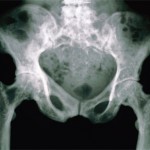My favorite part of the Jorvik Centre was the discussion of a Viking named Egril, son of Skalla-Grim. From skeletal remains, forensic experts established that Egril suffered from Paget’s disease, with a head made massive with Pagetic bone. This condition explained not only his grotesque and menacing appearance but also his legendary resistance to sword blows and other unkind attacks. The exhibit also noted that Egril had cold feet, lethargy, and headache. Did he have another condition that is all too common today?
Along with the picture of Egril’s distorted cranium was a disquisition on diseases transmitted from the Vikings. These diseases include Dupuytren’s contracture, which is called by some the Viking disease (Did you know that? I certainly didn’t); heart disease; multiple sclerosis; and Paget’s disease, which is also rampant in Iceland, another Viking hangout.
One of the most fascinating but mystifying aspects of modern genetics concerns the reason for the perpetuation of genes for bad disease. Why should the chromosomes harbor DNA sequences that do mischief, such as stirring up arthritis or lupus? The usual explanation is that the gene in another context provides a selective advantage, with its protein product fighting malaria or the bubonic plague, for example. While the exhibit did not make the point explicitly, I could not help but wonder whether genes that strengthen the bones against swords, maces, and lances could have also caused Paget’s disease to flourish. When your enemy’s name is Eric Bloodaxe, your caput needs all the density it can get.
Gene–environment interactions are tricky to decipher, but when people lived by the sword and died by the sword, an occasional case of Paget’s disease may been a small price to pay for a gene that makes the bones veritable armor. Did the brutal and unrelenting wars of the past put selective pressure on other genes? Maybe genes that promote blood clotting were a lifesaver for a soldier skewered on the battlefield. Scientists and religionists may both not like the idea, but I think that man is part of the environment that is making our genes evolve.
Enough musing and thoughts of the past. In a future column, I will describe what else I learned in York, this time about arthritis in modern England.
Dr. Pisetsky is physician editor of The Rheumatologist and professor of medicine and immunology at Duke University Medical Center in Durham, N.C.

